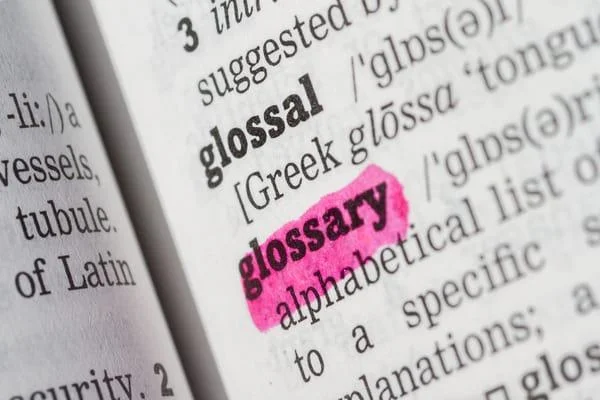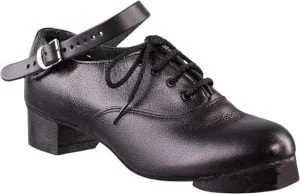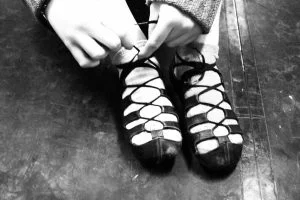When I entered the Irish dancing scene for the first time, I can say it was quite overwhelming. One of the big hurdles for me as a first-time Irish dance dad was understanding the Irish dancing terms and acronyms everyone was using.
It was an entirely new world, and to this day, there are still a lot of things that I don’t completely understand. Have you ever tried to understand how the scoring and place points work at a feis? (It’s actually not that difficult, really, but I digress…)
I felt like a real noob because I was, and it didn’t feel great.
I don’t want people to feel like that, so I thought that I’d try and help new dancers and dance parents get a head start. The idea was to create a concise glossary of Irish dance terms intended for the active Irish dance “supporter”, but that didn’t last long! It’s gotten a bit out of control.
In this article, I’ll we’ll explore some of the more common and some not-so-common terms and acronyms used in the Irish dancing world.
Table of Contents
Toggle
What is Irish Dance?
Definition of Irish Dance
Irish Dance is a traditional dance form originating from Ireland. It is characterized by quick and precise footwork, intricate movements, and tight upper-body placement. Irish Dance can be performed solo, in groups, or as part of a larger production.
Origins of Irish Dance
The origins of Irish Dance can be traced back to ancient Celtic rituals and celebrations. The influence of Gaelic culture and music is prominent in this dance form. Over the centuries, Irish Dance has evolved and adapted with influences from other dance traditions, creating a unique and distinctive style.
Why is Irish Dancing so stiff?
There are a couple of theories about this, but there is no definitive evidence to support any single theory.
One theory is that in the 18th and 19th centuries when Ireland was under British rule, the British tried to suppress Irish culture. Laws were imposed, and several cultural practices, including dancing, were forbidden. The Irish people continued to dance at home and deliberately kept their arms by their sides. This gave the impression that when looking in the window from the street, they were simply walking around the room. The upper half of their body was visible, but the lower half wasn’t.
An alternate theory suggests that keeping the arms tight by the side is because of practicality and space constraints. In the past, Irish dancing was often performed in small, crowded venues. To prevent accidental collisions and allow more dancers in the venue, the arms were kept by their sides.
Yet another theory is that when a group of Irish dancers was brought before the Queen to dance, they kept their arms by their side as an act of defiance.
At the end of the day, I guess that we will never actually know the real reason why Irish dancers keep their arms by their sides.
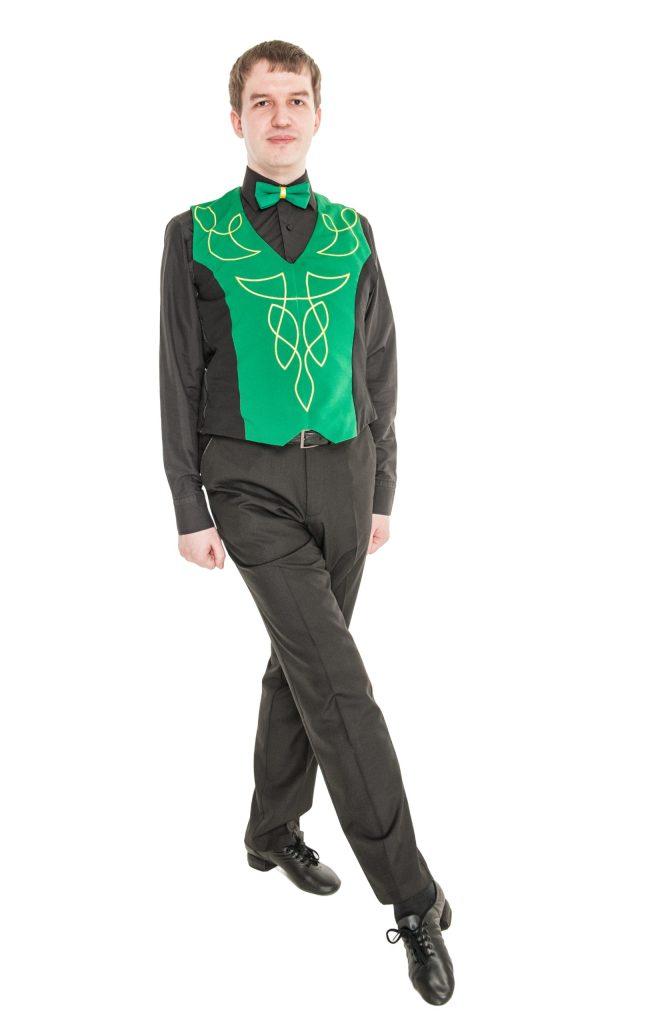
Types of Irish Dance
Irish Dance encompasses various styles and forms. The most well-known types include jigs, reels, soft shoe dances, hard shoe dances, hornpipes, and set dances. Each style has its own unique characteristics and steps, creating a diverse and rich repertoire of Irish Dance.
Some locations and countries have different terms when referring to specific dances, which can be very confusing. You’ll want to learn the terms used in your location. But for our purpose, I’ll just list them as best I can! I hope not to confuse you. If you are unclear, please talk to your trusted Irish dance teacher for clarification.
Another confusing thing is that Reels and Jigs can be either soft shoe or hard shoe dances. For example, a reel is a soft shoe dance, but treble reels are hard shoe dances.
To compound the confusion further, there are multiple types of Jig. The light jig, single jig, and slip jig are all soft shoe, but the treble jig is hard shoe. But in some locations, the single jig is soft shoe, and in other locations it’s hard shoe!
Let’s look at some of the terms:
Reel
A lively soft shoe Irish dance in 4/4 or 2/4 time signature, characterized by quick movements, intricate footwork, and a syncopated rhythm.
Single Jig
In some locations, this is a soft shoe dance, and other locations it is a hard shoe dance. In the locations where it is hard shoe, it may also be referred to as a “hop jig”, and provides rhythmic percussive sounds. In areas where it is a soft shoe dance, it is considered a beginner dance to teach the basis concepts. Please check with your TCRG for clarification.
Treble or Heavy Jig
This is a rhythmic and percussive hard shoe dance performed in a 6/8 time signature.
Jig or Light Jig
A traditional Irish dance in 6/8 time signature, featuring a light and bouncy rhythm, with emphasis on quick footwork and intricate patterns.
Slip Jig
A soft shoe dance in 9/8 time signature, characterized by graceful, flowing movements and intricate footwork. It emphasizes smooth transitions and jumps.
Hornpipe
A dance form in 2/4 or 4/4 time signature, with a distinctive rhythm and movements that imitate the movements of sailors. It is characterized by precision footwork and movements performed on the heels and toes.
Set Dance
There are two types of Irish set dance. Traditional Set Dance and Non-traditional Set Dance, (also called Contemporary Set or Own Choreography “OC” Set.)
The dances are performed in hard shoes to traditional Irish music. Examples of music for traditional set dances are The Blackbird, Garden of Daisies, and St Patrick’s Day.
Solo Dance
This is where the dancer has a choreographed piece to perform by themselves. Not part of a ceili team.
Ceili Dance
A traditional form of Irish social dancing performed in groups of two or more, often at social gatherings or ceili events. Celii dances include specific figure dances and formations, and dancers interact with each other in coordinated patterns.
Glossary of General Irish Dance Terms
Buckles
Buckles are decorative accessories worn on the front of hard shoes. They come in various designs and materials, adding a personalized touch to the dancer’s footwear.
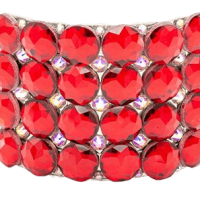
Ceili
Ceili (pronounced KAY-lee) is a traditional Irish group dance. It involves groups of dancers performing coordinated movements and formations to traditional Irish music. Ceili dances are often lively and energetic, creating a sense of community and camaraderie among the dancers.
Cummerbund
The cummerbund is a sash or broad waistband worn around the waist, typically as part of the male dancer’s costume. It complements the waistcoat and adds a formal touch to the overall attire.
Dress
The Irish dance dress, often referred to as the “solo dress” or “feis dress,” is the colorful and elaborate costume worn by female Irish dancers for competitions and performances. Solo dresses are adorned with intricate embroidery, sequins, and other decorative elements and can cost several thousand dollars.
Feis
A Feis (pronounced FESH) is an Irish dance competition. It is a platform for dancers to showcase their skills and compete against others in their age group and skill level. Feiseanna are often accompanied by live music and are a celebration of Irish dance and culture.
Feiseanna
Feiseanna (pronounced FESH-ah-na) is the plural of Feis.
Ghillies
Ghillies are the soft shoes worn by female Irish dancers. They are made of soft leather and have laces that crisscross over the top of the foot and are tied around the ankle. Ghillies are designed to be lightweight and allow for precise footwork and flexibility.
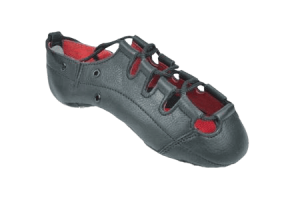
Hard Shoes
Hard shoes, also known as heavy shoes, are worn by both male and female Irish dancers for certain dances like treble reels and treble jigs. They have fiberglass tips and heels that produce a distinctive tapping sound when the dancer steps heavily on the floor.
Headband
Female Irish dancers may wear a headband, which is often decorated to match the costume’s design. The headband helps keep the wig in place and adds a finishing touch to the dancer’s look.
Oireachtas
Oireachtas (pronounced Or-ROK-tuhs) is an assembly or gathering. This name is usually used to identify a Regional Championship.
Poodle Socks
Poodle socks are special white socks worn by female Irish dancers. They are often adorned with a lace frill at the top, giving them a traditional and elegant look.
Waistcoat
Male Irish dancers often wear a waistcoat as part of their competition costume. The waistcoat is a sleeveless garment worn over the shirt and usually matches the overall color scheme of the costume.
Wig
Female Irish dancers often wear a wig as part of their competition costume. The wig is typically curly and made to resemble natural Irish dancing hair. It’s an important aspect of the costume, adding to the overall presentation and appearance.
Technical Irish Dancing Terms
Bird
A leap where one leg is pointed straight out horizontally and the other leg is tucked up under the body.
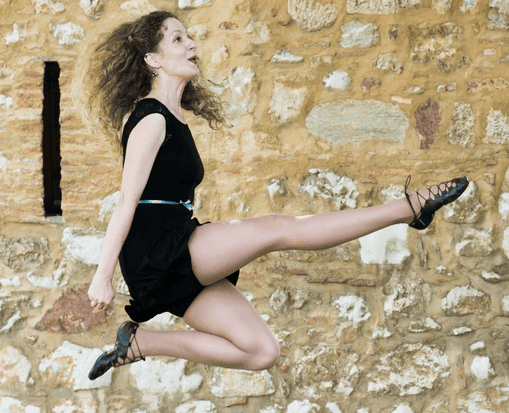
Brush
A movement where the dancer lightly brushes the ball or tip of the foot against the floor, creating a smooth and gliding sound.
Carriage
Carriage refers to the posture and positioning of a dancer’s upper body, particularly the arms, shoulders, and head. Proper carriage is essential for maintaining an elegant and poised appearance while performing Irish dance steps and routines.
Click
A movement where the dancer produces a sharp, audible sound by striking the heels of both shoes together. Typically seen when doing kicks.
Cross
A specific position where the dancers legs are crossed with one knee placed in front of the other.
Cross Key
A specific foot position where the feet are crossed at the ankles, with the working foot placed behind the supporting foot.
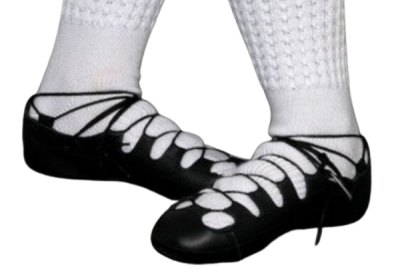
Cut
A movement in Irish dance where the dancer strikes the floor with the toe of the working foot, creating a percussive sound.
Heel
Referring to the heel of the foot, this term is often used to describe movements involving the striking or tapping of the heel against the floor.
Hop
A basic movement in Irish dance where the dancer jumps off one foot and lands on the same foot.
Hop Back
A movement where the dancer hops backward on one foot, often followed by other steps or used as a transitional movement.
Stag Leap
A dynamic leap where the dancer extends oneleg forward while the other is bent behind, resembling a stag’s leap.
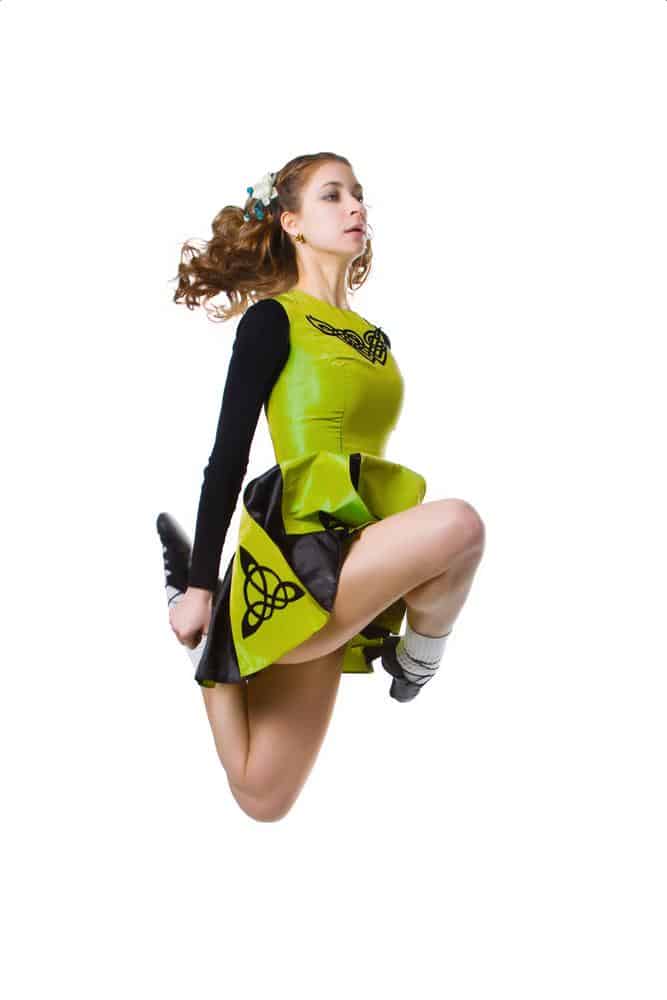
Stance
The specific position of the body and feet while performing Irish dance.
Switch
A movement were the dancer stands in place, with feet crossed and turned out.
Toe Stand
Balancing on the toes, typically performed in a precise and controlled manner.
Toe Stand Turn
A turning movement where the dancer balances on the toes of one foot and rotates in place.
Toe Walk
Walking on the balls of the feet, keeping the heels off the ground.
Treble Shuffle
A combination step in Irish dance that incorporates trebles and shuffles.
Treble, Rally or Batter
A term used to describe a specific type of Irish dance step where the dancer executes three distinct sounds in quick succession, typically performed on the balls of the feet.
Turnout
The rotation of the legs from the hip sockets outward, creating a 90-degree angle between the feet.
Irish Dance Competitions
Understanding Irish Dance Competitions
Irish Dance competitions are events where dancers compete against each other, showcasing their skills, technique, and choreography. These competitions are judged based on various criteria, including technique, execution, musicality, and presentation.
The competitions can run over several days. Dancers are separated into age groups and levels of ability. For example, beginner, primary, intermediate, and open are all levels of ability.
Becoming a Competitive Irish Dancer
If you want to be a competitive Irish dancer, you’ll need dedication, discipline, and be prepared for hours of practice working on technique, strength and performance skills. You will need to find a dance school that has qualified Irish dance teachers.
Irish Dance Competitions vs. Performances
While Irish Dance competitions are focused on showcasing technical proficiency and artistic expression, Irish Dance performances are more about entertaining and engaging the audience. Performances often incorporate storytelling, elaborate costumes, and live music to create a captivating and immersive experience.
Terms About Irish Dancing Competitions
Adjudicator (or Judge)
The person responsible for evaluating the performances of the dancers and assigning scores based on various criteria, such as technique, timing, presentation, and overall performance.
Championship Level
The highest level of competition for experienced and skilled dancers. Dancers at the championship level compete for prestigious titles and are often required to dance more complex routines.
Marshall (or Marshalling)
The process of organizing and lining up dancers before they perform on stage. Marshalls ensure that the dancers are in the correct order and ready for their turn.
Recall
The process of advancing to the next round or stage of the competition. Dancers who receive a recall are invited to dance in subsequent rounds or for final placements.
Terms Related to Irish Dance Teachers and Certifications
Teasgicoir Choimisiuin le Rinci Gaelacha (TCRG)
The Teasgicoir Choimisiuin le Rinci Gaelacha (TCRG) is a certification for Irish dance teachers. It is awarded by the Irish dancing commission and ensures that the teacher has the necessary skills, knowledge, and experience to teach Irish Dance.
Ard Diploma Choimisiuin le Rinci Gaelacha (ADCRG)
The Ard Diploma Choimisiuin le Rinci Gaelacha (ADCRG) is the advanced certification for Irish dance teachers. It is awarded to those who have demonstrated exceptional skill and expertise in teaching Irish Dance and have made significant contributions to the dance community.
Diploma Choimisiuin le Rinci Gaelacha (DCRG)
The Diploma Choimisiuin le Rinci Gaelacha (DCRG) is a certification for adjudicators and examiners in Irish Dance. It demonstrates their expertise in assessing and evaluating dancers’ performances and provides a standard for ensuring fair and impartial judging.
FAQ
Q: What is the meaning of ceili in Irish dancing?
A: Ceili refers to a type of Irish social dance that is performed in groups. It typically involves a series of traditional dances done to traditional Irish music.
Q: What is the terminology of Irish dance?
A: The terminology of Irish dance refers to the specific terms and vocabulary used in the world of Irish dancing to describe various steps, dances, and techniques.
Q: What is a feis in Irish dancing?
A: A feis is a traditional Irish dance competition. It is a gathering of dancers where they can showcase their skills and compete for prizes in various categories and levels.
Q: What does gaelacha mean in Irish dancing?
A: Gaelacha is an Irish word that means “Irish” or “relating to Ireland.” In the context of Irish dancing, it can refer to the specific style and traditions of Irish dance.
Q: What does rince mean in Irish dancing?
A: Rince is the Irish word for “dance.” It is used to describe the various dances performed in Irish dancing, such as the slip jig, light jig, and treble reel.
Q: What is Le Rinci Gaelacha?
A: Le Rinci Gaelacha is an Irish phrase that translates to “Irish dancing” in English. It is often used to refer to the overall practice and performance of Irish dance.
Q: Who is Ní Bhriain in Irish dancing?
A: Ní Bhriain is a common Irish surname that can be found in the world of Irish dancing. It is the last name of individuals who may be dancers, teachers, or otherwise involved in Irish dance.
Q: What is a Teasgicoir Choimisiuin Le Rinci Gaelacha?
A: Teasgicoir Choimisiuin Le Rinci Gaelacha is an Irish term that refers to a certified Irish dance teacher who has received accreditation from the Coimisiún Le Rincí Gaelacha, the governing body for traditional Irish dancing.
Q: What is an Ard Diploma in Irish dancing?
A: An Ard Diploma in Irish dancing is a high-level qualification awarded by the Coimisiún Le Rincí Gaelacha. It is a prestigious recognition of a dancer’s skill and expertise in Irish dance.
Q: What is an Ard Diploma Choimisiuin Le Rinci?
A: An Ard Diploma Choimisiuin Le Rinci is an Irish term that translates to “Advanced Diploma from the Coimisiún Le Rincí Gaelacha” in English. It is a significant achievement in the field of Irish dancing.
Q: What is NAIDC?
NAIDC stands for the North American Irish Dance Championships. It is one of the most prestigious and significant Irish dancing competitions in North America.
Q: What is CLRG?
CLRG stands for An Coimisiún Le Rincí Gaelacha and is the oldest and largest governing body for competitive Irish step dancing. The English translation is The Irish Dancing Commission.

